

If that sounds like you, consider a more mainstream router and spend the extra money on a better CPU, graphics card, or a bigger SSD so you can install more games. But spending more and making the right choice can make for a better gaming experience with less lag, especially if your home network and Internet bandwidth are split between several users and dozens of devices.Īll that said, a gaming router might be overkill for most people, particularly if you’re in a small apartment or house, without several people clamoring for your limited internet bandwidth. Unsurprisingly, this typically comes at a higher cost than most mainstream routers. And extra granular controls are tossed in for tweaking and streamlining your network performance to ensure it best serves your gaming needs.

Usually, features aimed at gamers are also included in the user interface to help prioritize gaming traffic and packets. This test allowed us to measure the router’s best-possible speeds while also stressing high-end routers more strenuously than the other models.But aesthetics aside, what makes a router a gaming router, let alone the best gaming router? In general, with a gaming router, you can expect higher-end internal hardware than budget offerings, including extra bands to handle more devices and often a faster CPU and more RAM to juggle a larger device load. This laptop also downloaded a very large file.
#Asus router comparison download
It tried to download data at up to 30 Mbps, but we were satisfied if it could average 25 Mbps or better, which is what Disney+ recommends for 4K UHD. One sat in the downstairs master bedroom and simulated a 4K video streaming session.Spending twice as much would buy only small improvements, and spending only half as much would mean giving up a lot. When considering both features and our test results, we look for “ the best for the most for the least.” Right now, paying around $110 for a router buys you excellent performance and features that offer real benefits. But we don’t consider the cheapest or the fastest to be the best. Price: You can buy a router for $20, and you can buy one for $500.The things we like to see that justify spending more include built-in security utilities, extra Ethernet and USB ports, and parental filtering. Nice-to-have extras: Fast, reliable Wi-Fi is what matters the most, but more expensive routers add features that bring other benefits.The slow processors found in cheap routers can drag things down. Fast processor and RAM: A router with a speedy multicore processor and extra RAM can handle more connected devices and offer improved performance.Multiple Ethernet ports: Ethernet ports give you unfettered access to the internet bandwidth you’re paying for.A great router minimizes that wait even if the network is busy. Low latency-test results: Slow internet sucks, and latency-or lag-is the time you have to spend waiting for the next thing to happen.We test each router to confirm whether it can stream high-quality videos on the far side of a living space. Good range-test results: You should be able to connect to a well-placed router from anywhere in an apartment or a small house.
#Asus router comparison update
Good speed-test results: In our tests, network speed, or throughput, varies from “this YouTube video will never finish loading” to “you can download a video game update in an instant.”.Any phone or laptop that you can buy today or may have bought in the past few years relies on one of these standards. Current-generation technology: Since we’re looking for routers that can improve your Wi-Fi, we consider only routers that support the Wi-Fi 5, Wi-Fi 6, and Wi-Fi 6E standards.


 0 kommentar(er)
0 kommentar(er)
